USU Eastern
Jennifer Leavitt Student Center
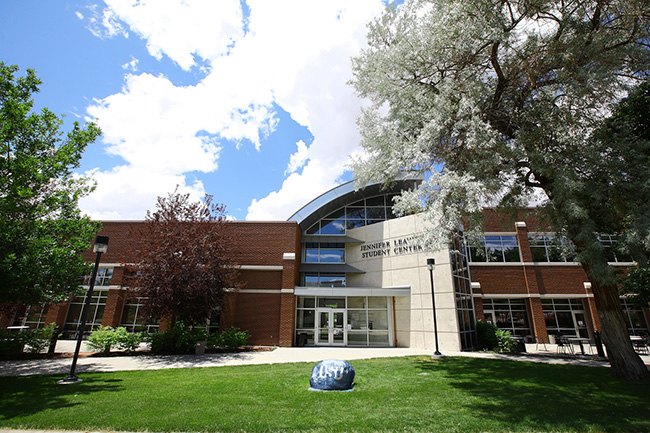
The College of Eastern Utah (now Utah State University Eastern) Student Center was named for Jennifer Leavitt, the granddaughter of Helen Leavitt, who donated money to CEU to provide scholarships. Jennifer died from cancer at the age of 18, never realizing her dream of going college to become a teacher.
Helen was educated in Carbon County and graduated from Carbon High School and the University of Utah. Helen had a longtime devotion to College of Eastern Utah and the education of young people in Carbon, Emery, Grand and Duchesne counties.
Near the front of the center sits a boulder, hauled onto campus by a group of freshmen in 1940. This now famous stone was promptly painted blue and named Gibby, short for Rock of Gibraltar.
McDonald Career Center
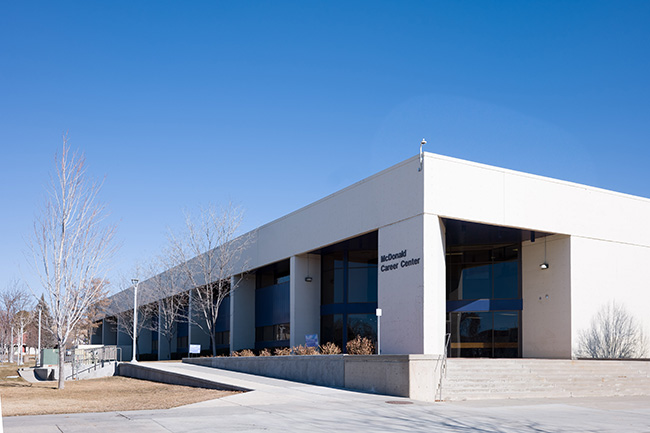
Merrill McDonald, born in Logan, Utah on September 5, 1918. He married Oma Alene Redd, August 30, 1942 in the Salt Lake LDS Temple.
Merrill received his bachelor’s and master’s at Utah State University and a doctorate of community college administration from Brigham Young University.
During his career, Merrill served as dean of students and assistant to the president of Treasure Valley Community College in Ontario, Oregon and as president of the College of Eastern Utah (now Utah State University) for ten years. He also was was assistant to the president of the Utah Valley State College Foundation Board.
During World War II, Merrill was a Second Lieutenant in the Army of the United States Air Corps as a Pilot/Navigator.
Bunnell-Dmitrich Athletic Center

Mike Dmitrich was born in Murray, Utah, but moved to Carbon County with his father when he was 5. During high school, he played football and basketball and was the football team captain, being honored as a “Big 9” all-star and receiving honorable mention on the 1953 all-state team.
Mike attended Utah State Agricultural College (now Utah State University) in 1954, after being recruited to play football, and, in 1955, was awarded a full-ride football scholarship. He returned to Price after being sidelined in Logan because of an injury and ended up playing for the College of Eastern Utah (now USU). In 1957, he began handling government affairs for Walker Bank, a local bank, and refereeing for just about every sport, at both high school and college levels. This combination of activities brought him to the attention of the Democratic Party in 1983. At the time, they were looking for someone to run for the Utah House. He held that position until 1990.
Omar Bunnell was born in Castle Dale, Utah. He graduated from Carbon High School and the University of Utah, where he was a champion debater and wrestler and a member of Phi Beta Kappa. Along with his brothers, he operated Bunnell Dodge and Bunnell Mobile Homes in both Price and Moab for many years. He was active in civic affairs, serving as president of the Price Kiwanis Club, Pro-Carbon Committee, member of Carbon County Chamber of Commerce where he was selected as `Boss of the Year,’ and on the board of directors for the Carbon-Emery Division of Zions Bank. Omar also participated on the “Save Carbon College” committee. He was an active member of the Democratic Party and served faithfully in the Utah State Senate for 27 years. He was chairman of the Utah Legislative Council’s Education Committee, and remained an advocate of education throughout his political career.
Curt Jensen Hospitality Room
BDAC 201

John Curtis “Curt” Jensen was born February 6, 1935 in Logan, Utah. Raised and educated in Sandy, Utah, he graduated from Jordan High School in 1953 with All-State baseball and basketball honors. As a 1957 graduate of the University of Utah, he was an All-conference and All-District member of the baseball and basketball teams.
Following college, he served in the U.S. Air Force in France, where he was player-coach on two European championship baseball teams. After the Air Force, he played five seasons of professional baseball, including two years with the Salt Lake Bees.
After working as an assistant coach at the University of Utah and Utah State University, he served 33 years in the athletic department at the College of Eastern Utah as baseball and basketball coach and athletic director.
Geary Event Center

Blending the old with the new, the Geary Event Center, originally completed in 1961, underwent a multi-million-dollar refurbishment, and is now the premier event center in the region, boasting a full LED house, state-of-the-art sound and a modern interior and seating.
Known as the jewel of Eastern Utah, the Geary Event Center was named for Professor Elmo Geary, as he was the driving force in getting the Geary Event Center Built. Professor Geary taught speech, debate and theatre from 1951 until his death in 1961, but his legacy, the program and the building continue to be a vital part of USU Eastern and its culture.
Paula and Edward R. Salzetti Ticket Booth

Edward Raymond Salzetti was born of Italian Immigrant parents in the mining town of Sunnyside, Utah on July 15, 1922. He attended schools in Sunnyside, played the saxophone and also played basketball on the high school team.
Edward was drafted into the United States Army in December of 1942. He was assigned to the 48 Tank Battalion, of the 14 Armor Division. Edward met Paula Gah shortly after World War II ended in May of 1945. He was traveling along the autobahn in his Jeep and saw this petite young woman pushing her bicycle. He later saw her at a dance in Munich. They continued to meet at dances that were held in the various German towns, many sponsored by the military. They fell in love and married on November 12, 1947.
Edward went to work for the United Nations Relief and Rehabilitation Administration (NRRA) after being discharged from the Army in February of 1946. He was assigned as the supervisor for the supply and transportation of a hospital. The NRRA was formed to help those who had been displaced by the ravages of World War II. After working for the United Nations, Edward worked as a department supervisor of high value items in a large warehouse for the Army Exchange (PX) System. Material of all kinds from all over Europe came into this large warehouse and was then sorted and distributed throughout the European Theatre.
Edward and Paula were required to leave Germany within 30 days of their marriage; a policy of the Allied Command at that time. They lived with Edward’s brother and sister-in-law in Spring Glen, Utah, for a few months, until they could get on their feet. After Edward found work at Kaiser in the maintenance department and the couple rented an attic in a house in Spring Glen. They used orange crates for cupboards and obtained a limited amount of used furniture. They saved their money and eventually purchased a house in Price.
Shelton and Sharon Wakefield Steinway Piano
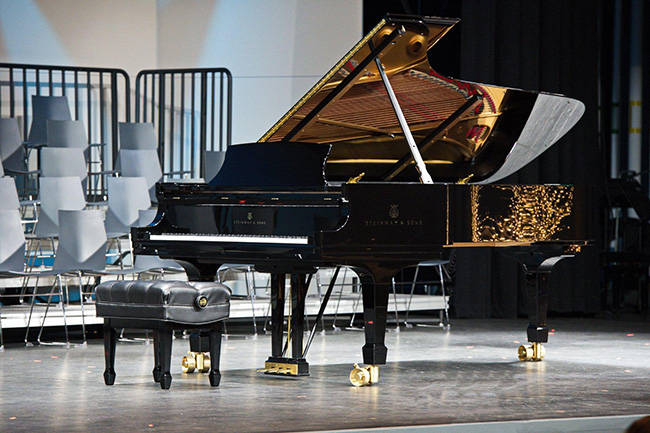
Shelton and Sharon Wakefield have a long-treasured connection with education. Shelton was born in Huntington, Utah and graduated from Carbon College (now Utah State University Eastern) in 1959 with an associates in education before continuing his studies at the University of Utah. Following graduation, Shelton began his career as a teacher. After five years of teaching school, Shelton took a job with Conoco Oil, where he worked in corporate training and development until retirement.
Shelton met his bride-to-be at Carbon College, where they were both involved in music and band. They developed a relationship while traveling together by bus on band trips. Sharon was born in Idaho and moved to Price, Utah as a young girl. After studying at Carbon College and the University of Idaho, she earned her teaching degree from Brigham Young University. She retired from teaching after a remarkable 30 years of service.
Gomer Peacock Memorial Room
When the original 1937 Carbon College’s (College of Eastern Utah, now Utah State University Eastern) Reeves’ Building was torn down in December 2003, the Gomer P. Peacock Room fell in the ruins with the building. The room was well-known to the campus community as a tribute to one of the men who helped save the college in 1953 when a maverick governor wanted to close the institution and return it and three other two-year colleges to the Church of Jesus Christ of Latter-day Saints. The new Reeves’ Building was dedicated in September 2004 without an official Gomer P. Peacock Room. However, in November 2005, the Peacock family gathered in Price to dedicate an electronic-conference room in his memory.
Gomer, a Price businessman, led the fight to not only keep the college open, but provided the support to ensure its survival and growth in the future.
Then Utah Gov. J. Bracken Lee, former mayor of Price, who helped secure the property the college is built on, decided Utahns were paying too many taxes and wanted to cut the state budget. Lee felt the state could not afford to finance the nine institutions of higher education. In a special December 1953 legislative session, Gov. Lee proposed Carbon College be closed and its land and property sold. He convinced the legislature to support his recommendations. The citizens of Southeastern Utah were outraged at the news.
According to news reports, almost immediately, efforts were started to try to save the Carbon College by forcing a popular vote to reverse the actions of the Utah Legislature. Gomer was selected to head up the effort to obtain the signatures needed to put the measure to save the colleges (retain ownership in Dixie, Snow, Weber and save Carbon) on the November ballot, develop supporting materials to send out to voters, raise money to collect signatures and mail materials and convince a majority of Utah voters to reject the recommendations of Governor Lee and the Utah Legislature. Gomer led a committee of Carbon County’s leading citizens in an unprecedented united effort in what must have seemed an insurmountable task to save the college.
The “Save Carbon” group opened an office in the Crown Theatre building in Price to coordinate the collecting of signatures, develop materials and raise funds to support the effort. Many of Carbon College’s student body officers and students traveled throughout the state to gather signatures to save the state colleges. They turned into the governor more than double the number of signatures needed to force a ballot to save the colleges during the November general election that year.
Lee Family Reading Room
LLC 108
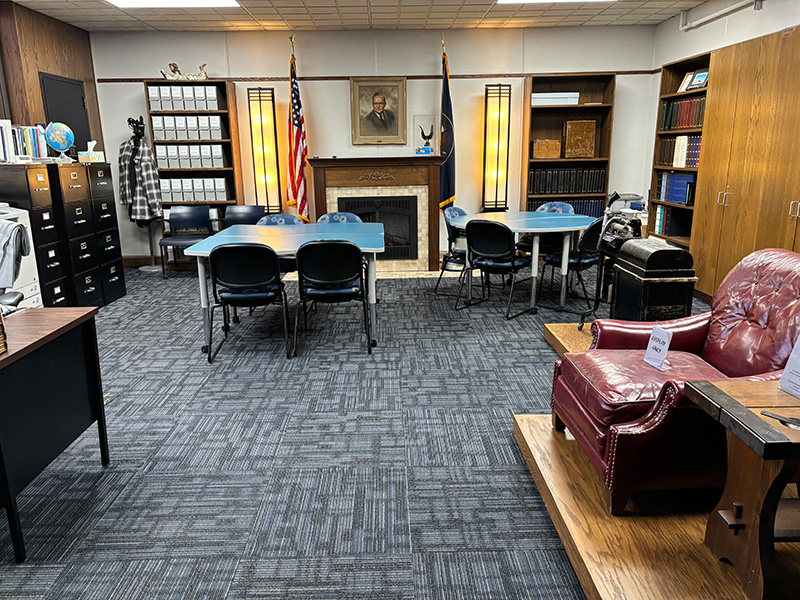
J. Bracken Lee was born in Price, Utah, on January 7, 1899. The Lee family moved to Fruita, Colorado, when Lee was five years old. He attended school there, completing the eighth grade before the family returned to Price. Lee attended Carbon County High School, but did not graduate; instead, two months prior to graduation, he enlisted in the U.S. Army when World War I broke out in April 1917. He served until March 1919, emerging with the rank of sergeant. After leaving the service, he worked for several months as a postal clerk before joining his father in the insurance and real estate business, eventually becoming manager and owner of the agency.
In 1922, Bracken married Nellie Pace, and they had a daughter, Helen. After two years of marriage his wife became seriously ill with pneumonia, then with Hodgkin’s disease, which took her life in 1926. In 1928, Bracken married Margaret Draper from Wellington, Utah, and they became parents of three children.
In addition to managing his insurance business, Bracken became a registered Republican, a 32nd-degree Mason, an Elk and a Legionnaire. By 1931 he had become so involved in Price politics that he ran for mayor; however, he was swamped. He ran again in 1935, winning by two votes. He was elected to five additional two-year terms for a total of twelve years in office. Bracken served two terms as Utah governor (1949-57), three terms as mayor of Salt Lake City (1960-72) and seemed to be a perennial candidate for governor and senator as well as a forceful spokesman for conservatism.

Bess Riggs Jones Room
LLC 109
Bess Riggs Jones was born March 1, 1889 in Orrick, Missouri. Bess taught at the Bingham Canyon Junior High School from 1916 to 1919, when she left to teach in Fredonia, Kansas, and later, Lathrop, Missouri. She returned to Utah in 1926, coming to Price where she began teaching English and Latin at Carbon High School.
Bess remained on the high school faculty until 1945, when she joined the faculty at Carbon College, advancing to the position of dean of women until her retirement in 1958. Following her retirement, she attended lecture courses at Carbon College not for credit, but to satisfy her unquenchable desire for knowledge and association with young people to whose education she devoted her life.
Dorothy Brown Choral Studio
CIB 120

Twenty-eight years after her passing, Dorothy Brown was inducted into the Utah Music Educator’s Hall of Fame. Dorothy worked for 34 years as a choral director and music educator in the elementary, secondary and college level. Her choirs consistently took top awards in regional, state and multi-state competitions. Whether at home, school or church and civic settings, Dorothy promoted a love of music throughout the community and state. An excellent piano and vocal coach, she taught piano and voice lessons in her home.
Deane Brown Instrumental Studio
CIB 122
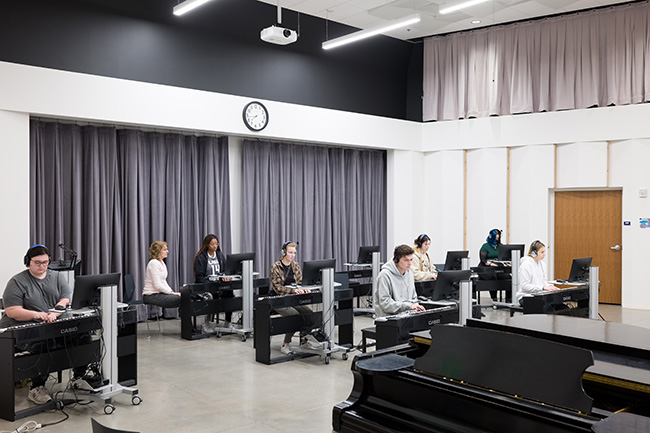
Deane Brown taught alongside his wife, Dorothy, as a music teacher at Mount Harmon Junior High School in Price, Utah. Deane graduated magna cum laude from Brigham Young University in 1942 and received a master’s in 1959.
Peterson Blackbox Theatre
CIB 126

Joe Peterson, vice president for instruction at Salt Lake Community College, was named first chancellor of the newly formed Utah State University College of Eastern Utah in 2010.
Joe began his career in 1982 as an instructor of English at Utah State University. He went on to Dixie State College as a faculty member prior to becoming dean of Arts, Letters and Science at Dixie. He then became interim academic vice president and vice president of student services at Dixie before taking on his duties at SLCC.
Joe received a doctorate in educational leadership from the University of Nevada, a master’s in English from Brigham Young University and a bachelor’s in English from BYU.
Aaron Jones Hall

Aaron Eugene Jones was born April 28, 1892 in Bountiful, Utah, the youngest of eleven children. Aaron was the only member of the family who had the opportunity to receive an education beyond the eighth grade. He received a doctorate from the University of California, Berkeley in 1938.
Aaron subsequently joined the faculty of Carbon College (now Utah State University Eastern) in Price, Utah, where he assumed the position as the second president of the college in 1944. He was instrumental in helping to rally statewide support for the college when it was threatened with closure in the 1950s.
Burtenshaw Hall

Claude J. Burtenshaw was born a farmer’s son on February 14, 1918 in Shelton, Idaho. In 1937, Claude served a Church of Jesus Christ of Latter-day Saints Eastern States mission for two years. Upon his return, he attended Ricks College, earning a two-year teaching certificate. Clause was hired as a teacher in Osgood, Idaho, when he met another teacher, Frances Davis from Shelley, Idaho. The couple married on May 27, 1942 in the Salt Lake Temple, but World War II soon intervened. With his rich mellow voice, Claude was asked to sing patriotic songs to encourage enlistment in the military. Soon, he sang himself right into the Army Air Corp. He served for three years in North Africa and Italy as a cryptographer and assistant chaplain for servicemen of all religions.
Arriving home, Claude met his 3-year old daughter for the first time. He then attended the University of Utah where he earned a bachelor’s, master’s and doctorate in political science and philosophy. In 1952, he returned to Ricks College as a political science professor and debate coach. He was soon involved in local and state politics and served two sessions in the Idaho legislature, running three times for the U.S. Senate. Claude was a leading advocate in the campaign to keep Ricks College of Rexburg open.
In 1959, Claude was chosen as president of College of Eastern Utah (now Utah State University Eastern) in Price, which he led for three years. In 1962, Utah State University offered Claude the position of dean of students. He later became a vice president at the institution and also served as a professor of political science. Claude directed the Peace Corps programs at USU and its special Honors programs. He formed combined student and faculty and administration councils during the volatile 1960s period of campus revolts, involving students to help find successful solutions to student issues. Claude was a favorite professor teaching political science, philosophy, ethics, American government and U.S. Constitution. His lifetime of education spanned 53 years.
Sessions Hall
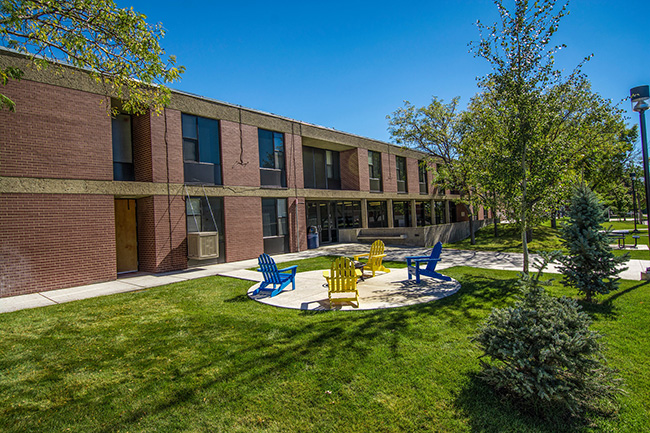
With three new buildings and 11 instructors, fall semester classes began in October 1938 with Eldon B. Sessions appointed as Carbon College’s first president. One hundred students enrolled representing nine states its first quarter. Sessions was new to the community and the yearbook staff wrote that the successful organization of the institution and the enthusiastic spirit of the student body was attributed to the new president. Sessions’ Residence Hall is named after Carbon College’s first president who served from 1938-44.
John W. Tucker Hall

Teaching and serving were central to the life and career of John Winn Tucker, who died Dec. 18, 2001. Born on Jan 10, 1926 in Salt Lake City, Utah, he was the first in his family to go to college. He went on to navigate the difficult waters of college administration on the campuses of the 1960s and 1970s, and was devoted to the idea that learning should be a joyous experience and, that given time, “anyone can learn anything if you want to bad enough.”
John’s long career in education took him to positions in St. George, Utah; Idaho Falls, Idaho; Provo, Utah; Price; Salt Lake City, Utah; and Westville, Indiana. His positions included classroom instructor, school superintendent, dean of students, president of the College of Eastern Utah, vice president at the University of Utah and chancellor at Purdue University North Central.
*Note: All bios are current and up-to-date as of Summer 2022.

